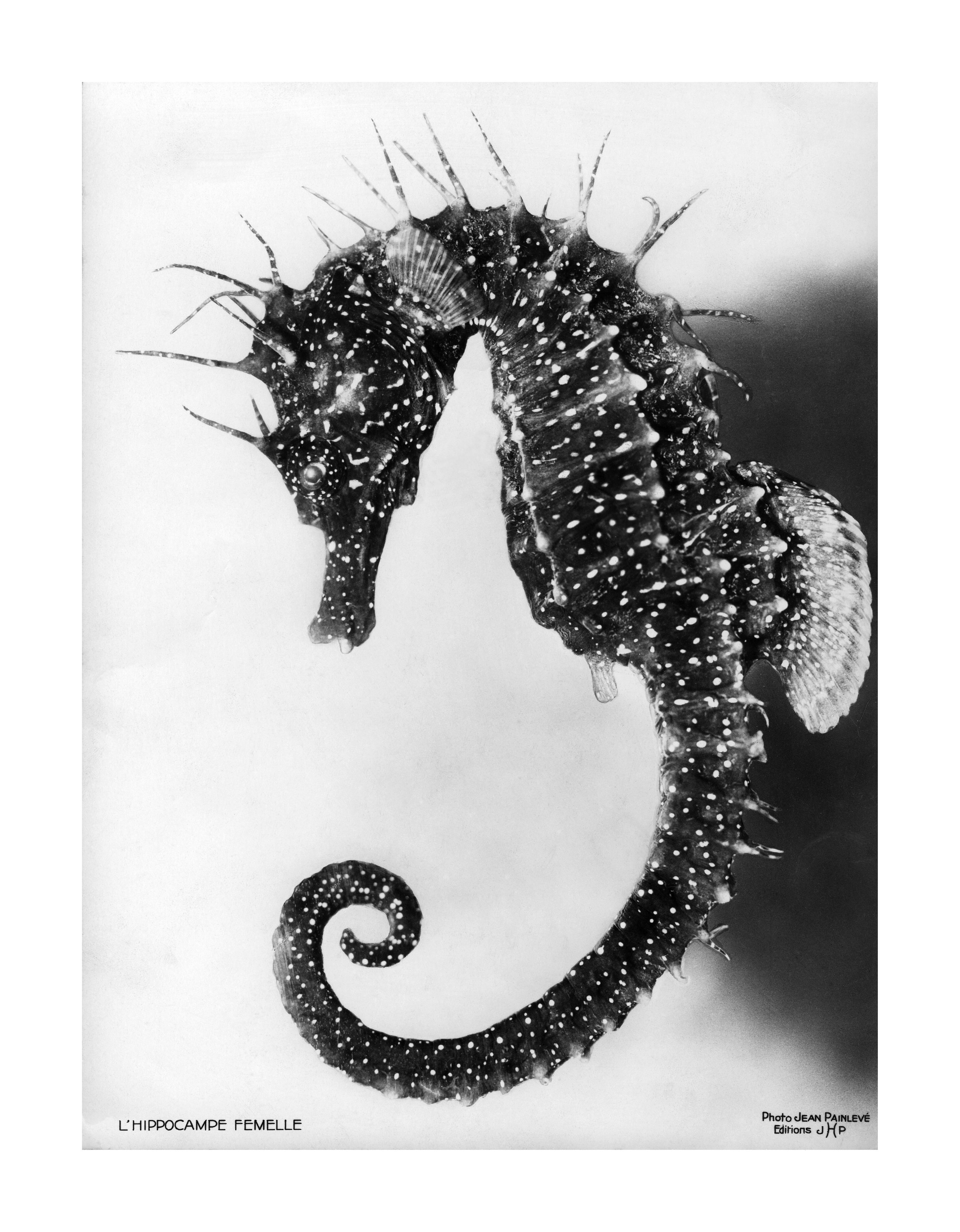Fotomuseum | Winterthur
29. Oktober 2022 - 12. Februar 2023
Jean Painlevé, L’Hippocampe Femelle, ca. 1934 © Les Documents Cinématographiques – Archives Jean Painlevé, Paris
Der französische Regisseur Jean Painlevé (1902–1989) widmete sich zeit seines Lebens mit grosser Leidenschaft und Hingabe dem wissenschaftlichen Film und der Dokumentation der Fauna, insbesondere der Tierarten der Unterwasserwelt. In gut 50 Jahren drehte Painlevé über 200 Kurzfilme, die sich durch seine ebenso akribische wie experimentelle Herangehensweise sowie seine technischen Finessen auszeichnen. Die Werke, die in der Ausstellung gezeigt werden – eine Auswahl zahlreicher Schwarz-Weiss- und Farbfilme, Fotografien und Dokumente –, spiegeln seine Faszination für die Wissenschaft wider aber auch sein Bedürfnis, das Staunen über die Tierwelt, die unsere Welt bewohnt, zu teilen.
Jean Painlevé beobachtete seine Motive genau und hielt ihre Bewegungen und Entwicklungen fest. Dabei interessierte er sich insbesondere für Krebse, Krabben, Seesterne oder Seeigel, deren Lebensraum die Küstenlandschaft ist, vor allem das Vorland – der durch die Gezeiten abwechselnd von Wasser bedeckte und freiliegende Grenzbereich zwischen Land und Meer. Seine Aufnahmen, von denen er viele in Zusammenarbeit mit seiner Lebensgefährtin und Kollaborateurin Geneviève Hamon (1905–1987) realisierte, geben den Zuschauer_innen einen ungewohnten Blick in die wunderliche Welt von Unterwasserkreaturen und ihren fremdartigen Körpern.
Eine Ausstellung des Jeu de Paume, Paris, Adaption durch das Fotomuseum Winterthur. Kuratorin: Pia Viewing in Partnerschaft mit Brigitte Berg, Direktorin des Les Documents Cinématographiques / Archives Painlevé, Paris.
Le réalisateur français Jean Painlevé (1902-1989) s'est consacré toute sa vie avec beaucoup de passion et de dévouement au film scientifique et à la documentation de la faune, en particulier des espèces animales du monde sous-marin. En un peu plus de 50 ans, Painlevé a réalisé plus de 200 courts métrages qui se distinguent par leur approche aussi méticuleuse qu'expérimentale ainsi que par leur finesse technique. Les œuvres présentées dans l'exposition - une sélection de nombreux films en noir et blanc et en couleur, des photographies et des documents - reflètent sa fascination pour la science mais aussi son besoin de partager l'émerveillement face au monde animal qui habite notre planète.
Jean Painlevé observait attentivement ses sujets et enregistrait leurs mouvements et leurs évolutions. Il s'est notamment intéressé aux crabes, aux crevettes, aux étoiles de mer ou aux oursins, dont l'habitat est le paysage côtier, et plus particulièrement l'estran - cette zone frontière entre la terre et la mer, alternativement recouverte et découverte par les marées. Ses clichés, dont beaucoup ont été réalisés en collaboration avec sa compagne et collaboratrice Geneviève Hamon (1905-1987), offrent aux spectateurs un regard inhabituel sur le monde merveilleux des créatures sous-marines et de leurs corps étranges.
Une exposition du Jeu de Paume, Paris, adaptée par le Fotomuseum Winterthur. Commissaire : Pia Viewing en partenariat avec Brigitte Berg, directrice des Documents Cinématographiques / Archives Painlevé, Paris.
Per tutta la vita, il regista francese Jean Painlevé (1902-1989) si è dedicato con grande passione e dedizione al cinema scientifico e alla documentazione della fauna, in particolare delle specie del mondo sottomarino. In ben 50 anni, Painlevé ha realizzato oltre 200 cortometraggi, caratterizzati da un approccio altrettanto meticoloso e sperimentale, oltre che dalla finezza tecnica. Le opere esposte nella mostra - una selezione di numerosi filmati in bianco e nero e a colori, fotografie e documenti - riflettono il suo fascino per la scienza ma anche il suo bisogno di condividere la meraviglia della fauna selvatica che abita il nostro mondo.
Jean Painlevé osservava da vicino i suoi soggetti e ne registrava i movimenti e gli sviluppi. Era particolarmente interessato a granchi, gamberi, stelle marine o ricci di mare, il cui habitat è il paesaggio costiero, in particolare la battigia - l'area di confine tra terra e mare alternativamente coperta dall'acqua ed esposta dalle maree. Le sue fotografie, molte delle quali realizzate in collaborazione con la sua compagna e collaboratrice Geneviève Hamon (1905-1987), offrono agli spettatori uno sguardo insolito sul mondo stravagante delle creature subacquee e dei loro strani corpi.
Una mostra del Jeu de Paume, Parigi, adattata dal Fotomuseum Winterthur. Curatore: Pia Viewing in collaborazione con Brigitte Berg, Direttore di Les Documents Cinématographiques / Archives Painlevé, Parigi.
French film director Jean Painlevé (1902–1989) had a passion for scientific cinema. He was interested in engaging a broad audience in the discovery of natural science through film and devoted most of his life to documenting fauna – especially species from the underwater world. Over a period of more than 50 years, Painlevé shot over 200 short films, marked by his characteristic approach, which he developed through meticulous observation, technical mastery and experimentation. The works in the exhibition – a selection of numerous black-and-white and colour films, photographs and documents – reflect not only his engagement with science but also his desire to share the mysteries of living matter and creatures that inhabit Earth.
Painlevé made precise observations of his subjects and recorded their movements and processes of development. He began by concentrating on crabs, shrimps, octopuses and sea urchins – creatures that inhabit the coast, especially the foreshore, the border zone between land and sea that is washed by the tides. His films, many of which were made together with his lifelong partner and collaborator Geneviève Hamon (1905–1987) , offer visitors an unusual journey into the curious world of underwater creatures, their bodies and their habitats.
This exhibition is conceived by Jeu de Paume, Paris with the participation of Fotomuseum Winterthur for its presentation in Winterthur. Curator: Pia Viewing in association with Brigitte Berg, Director of Les Documents Cinématographiques / Archives Painlevé, Paris.
(Text: Fotomuseum Winterthur)

